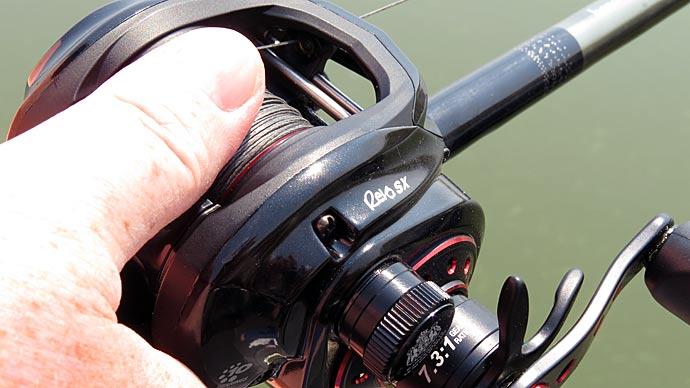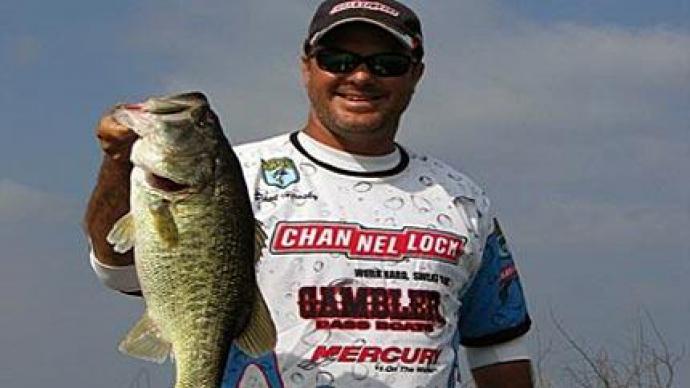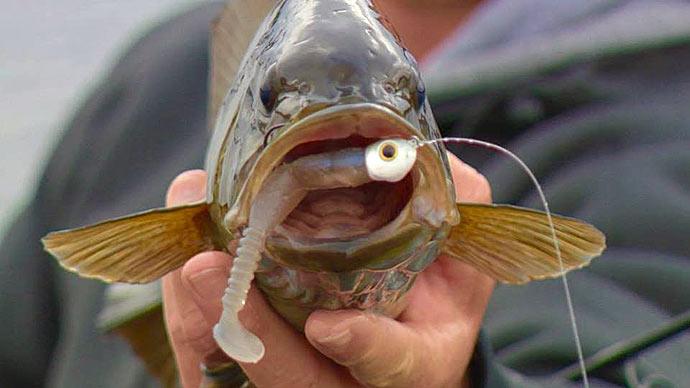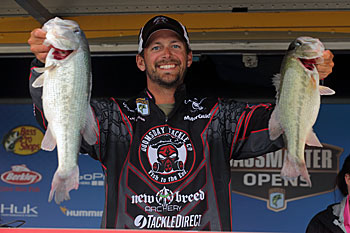
Swimbaits are a shallow-water staple for many bass anglers. Texas rigged or with a treble hidden underneath, they can be fished through and around heavy cover, including aquatic vegetation, laydowns, and docks, without the worry of snagging. And their lifelike profile and action draw strikes from plenty of bass.
Bassmaster Elite Series angler David Mullins is in that group. But after a simple discovery, he joined one more. “We figured out we could put a big jig head in there, and bass would eat a swimbait well in deep water,” he said. That’s proved to be a good thing for him.
Deep swimbaits played a role in Mullins’ victory at the 2016 Bassmaster Open on Douglas Lake, near his Mount Carmel, Tennessee, home. Following runner-up finishes in 2013 and 2014 at the tournament, he caught 15 bass over three days, weighing 62 pounds and 12 ounces, to win. The bass he targeted were in 10 to 30 feet. While he caught most on a crankbait, a 6-inch swimbait added key bass to his daily limits, ensuring the win.
Mullins started fishing swimbaits along deep river-and creek-channel ledges on his home lakes, but he quickly found they are an easy way to put a moving lure in front of deep bass anywhere. He’s caught bass with the technique at Sam Rayburn Reservoir in Texas and Kentucky Lake. He even threw one on the St. Lawrence River in Northern New York to catch smallmouth bass. “It’s not just something for the Tennessee River lakes,” he said.
Deep is a relative term. On some bodies of water, it might be 10 or 12 feet. And others, like those around Mullin’s east Tennessee home, might be 40 or more feet. Regardless of the actual depth, the tactics are the same. Focus less on that number and more on selecting, rigging, and retrieving your swimbait.
Selecting
Mullins’ swimbaits range from about 3 inches to 8 inches long. When targeting largemouth, he selects ones at the larger end of the spectrum — 5 to 8 inches long. They’re at their best early in the year, he said, when aggressive prespawn bass want large meals, but they’ll produce anytime largemouth are feeding deep.
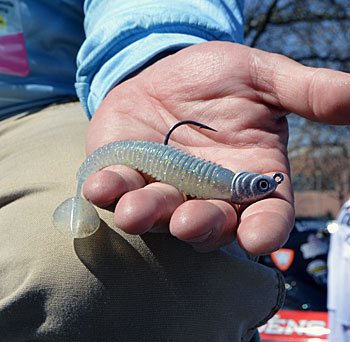
Mullins is more likely to select a smaller swimbait — 3 to 4 inches long — when he’s targeting smallmouth. While they closely match the baitfish size in Northern fisheries, they don’t always equal small bass. “You can still catch big ones on them,” he said. Proof of that can be found at any recent Bassmaster Elite Series tournaments on St. Lawrence. Competitors brought in five-bass limit after five-bass limit of giant smallmouths, many near or topping 20 pounds. While most were caught on a drop shot, plenty fell to small swimbaits.
Sometimes Mullins wants to catch small bass. “If you’re having trouble getting bit, you can go to a smaller one,” he said. He’ll exchange his big swimbait and tie on a small one, such as a Keitech Swing Impact 2.8, to play a numbers game.
Once you’ve settled on the size of swimbait you want to fish, you’ll need to pick one. That’s not a straightforward process. “Each one has a little different kick or profile,” Mullins said. Both of those characteristics are important. Swimbaits with larger tails that are 90 degrees to their bodies, for example, create a stronger swimming motion than those whose tails are smaller or angled back. Finding the specific one can be trial and error, using current conditions to narrow down the possibilities.
Mullins often chooses hand-poured 5- and 6-inch Scottsboro Tackle Co. swimbaits when he wants a large profile. He helped design some of their colors, including Mullins Madness. Its greenish back and silver belly, which sports some pink hues, looks like a big threadfin or gizzard shad in the water. He is nearly always trying to match the color of those baitfish with his swimbait.
Rigging
Bassmaster Elite Series angler Steve Kennedy also fishes swimbaits for deep bass. It makes no difference if his target is largemouth or smallmouth; he wants to accomplish the same thing when rigging them. “You have to have a [heavy] enough jig head to get it to the right depth and get your line to come through the water without [the swimbait] rising,” he said. “That’s the key.”
Kennedy isn’t afraid to use jig heads that weigh as much as ¾ ounce with 4-inch swimbaits. He used that combination to entice bass from 30 feet of water at the 2018 Bassmaster Classic on Lake Hartwell, which lies along the South Carolina and Georgia line. Mullins wants the same result, so he starts with heavy jig heads for large swimbaits, moving up to as much as 1 ¼ ounces in the deepest spots.
Mullins’ jig heads are custom poured, but what he requests can be found in some mass-marketed versions. He likes a screw lock to keep the swimbait straight, which allows the tail to create its bass, attracting thump. It also keeps it on the hook. Without one, a large swimbait can separate from its jig head during a cast or while battling a thrashing bass, the likelihood increasing as the swimbait wears with use.
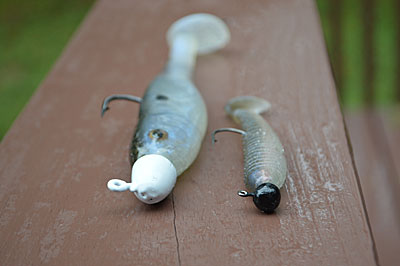
Mullins uses bullet-shaped jig heads for large swimbaits. They help his offering sink fast and add action while swimming it back. They sport hooks from 5/0 to 8/0, which he matches to the swimbait’s length. If they stretch too far along a swimbait, they make it rigid, killing some of its action.
Mullins puts his smaller swimbaits on ball-shaped jig heads with 3/0 hooks. His selection includes ones that weigh from 1/8 ounce through 3/8 ounce. He switches to heavier ones as depth, or in some cases current, increases.
Swimbait size also determines the rod, reel, and line Mullins uses. He throws the smaller 3-inch models on a Doomsday Tackle Co. 7-foot 3-inch spinning rod with medium-light power. He matches it to a Shimano Ci4 spinning reel that’s loaded with 12-pound test braided line and a leader of 7-pound test Sunline Sniper fluorocarbon. He said the leader material is limp, and its diameter is smaller than the 8-pound test, so it sinks faster. It also has more strength than 6-pound test. “I’ve straightened 3/0 hooks with it,” he said.
Bigger swimbaits demand stronger gear. Mullins again grabs a 7-foot 3-inch Doomsday Tackle rod, but this one is a heavy-action casting model. He adds a Shimano Curado K reel with a 7:1 gear ratio. “I don’t like a high-speed reel for [deep swimbaits],” he said.
Mullins spools his casting reel with 18-pound test Sunline Shooter fluorocarbon line. If he is fishing 40 feet or more, he’ll drop down to 16-pound test. Its smaller diameter offers less resistance, letting it sink faster and stay deeper.
Retrieving
Fishing a swimbait in deep water starts like you’d fish a crankbait. Kennedy recommends taking care to line up your casts. That way, your swimbait has room to reach the bottom before your retrieve brings it across the sweet spot, such as a rock or stump on the end of a point.
And regardless of the cover on that structure, you’ll worry less about getting snagged with a swimbait. Kennedy said its single upturned hook is less likely to catch on something compared to a crankbait, whose double treble hooks hang exposed on the underside.
How you retrieve your swimbait is as important as where you cast your swimbait. Even with a big weight trying to pin it to the bottom, Kennedy winds his reel slowly. “If you aren’t reeling slow enough, it will rise off the bottom,” he said. “So, you have to pause it and let it fall.”
Mullins also prefers a slow retrieve, so he chooses a casting reel with a 7:1 gear ratio. But how slow he goes depends on where the bass are in relation to the bottom. If they’re suspended a few feet above it, he’ll let his swimbait sink to the bottom and then start a continuous retrieve that’s just fast enough to keep it swimming among them. If they’re tight to the bottom, he’ll let his swimbait sink there, then crank his reel a couple of times and stop, letting his lure return to the bottom. “They can see it and follow it back down,” he said
BassResource may receive a portion of revenues if you make a purchase using a link above.


